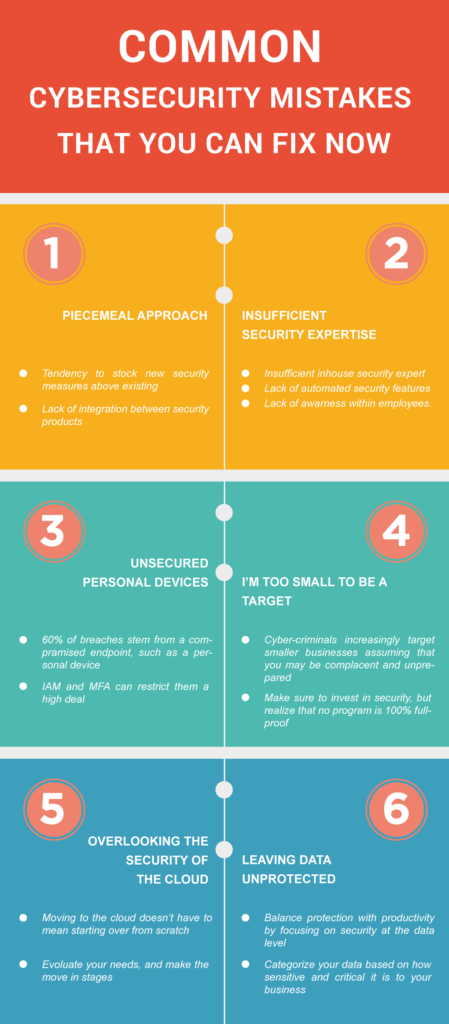Introduction
Cybercriminals are shrewd and always on the lookout for vulnerable businesses. They exploit mistakes and flaws to breach systems, then hack into your system to get crucial information of your businesses for ransom. Therefore, you always need to be cautious and extra careful to avoid being an easy target. There are ways that you can adopt to reduce the likelihood of a successful attack.
Below are six common cybersecurity mistakes and the ways to fix them
1. Security being compromised
Cyberthreats continue to increase every passing day, and 43% of cyberattacks target small businesses,1 as they usually have limited IT resources in-house. Everyone else is concerned and focused on running the business, not security.
You need help. You can consider automated, software-based processes to monitor your systems continuously and even take action when a threat is detected. You can save your time and energy by making use of smart automation, allowing you to focus on other priorities.
Also, consider involving a specialized security provider. And finally, educate your employees on security awareness so everyone can be part of the solution
2. Piecemeal approach
As new threats emerge, it is tempting to stack new security measures on top of existing ones. But this does not help because of too many products and not enough integration. Every product has its own dashboard, alerts, and control. And someone needs to stay on top of it all.
The lack of integration between security products makes it difficult to see threats holistically and makes it difficult to respond quickly and effectively. Henceforth, look for products designed to work together, and associate with companies that actively seek collaboration with the security industry.

3.Underestimating your business
Cybercriminals increasingly target smaller businesses assuming that you may be unprepared.
A study by the Better Business Bureau found that nearly one in four businesses with 250 or fewer employees are reported having been the target of a cyberattack, and the overall annual average loss of $79,841 is estimated from these attacks for smaller businesses.
This makes it relevant that how important it is to invest in security, but at the same time realize that no program is 100% foolproof. Therefore, assume that you can be attacked and breached.
So, prepare an incident response plan, ensure continuous vigilance for suspicious activity, and organize the resources needed for a quick response to reduce the damage to your business.
4. Not securing your personal devices
There are so many ways by which you can access your business data that makes it vulnerable in terms of security.
Even small businesses may have multiple devices like computers, laptops in remote locations, personal smart phones, and tablets. A hacker can attempt access through many possible endpoints. In fact, 60% of breaches arises from a compromised endpoint, such as a personal device.
Identity and access management (IAM) helps to eliminate the complexity of multiple user credentials by giving each employee a single, secure identity to access all your network resources.
Another layer of protection is provided by multi- factor authentication (MFA), requiring a user to present a password plus secondary authentication such as code sent via SMS or a fingerprint.
5. Unprotected Data
Data travels outside your control when it’s shared by employees, customers, and partners. But trying to lock down everything discourages innovation and productivity, and eventually leads to employee workarounds if the inconvenience proves too great. Balance protection with productivity by focusing on security at the data level.
Categorize your data based on how critical and sensitive it is to your business. Better yet, automate your data classification so that the appropriate monitoring and protections are in place when the data is created. Protect what’s most important with the strongest measures, such as restricted access, limited sharing privileges, and encryption.
6. Overlooking the security of Cloud
Security is complex, and even well-funded enterprise IT departments struggle to stay on top of it. The right cloud partner can help you protect your workloads from unauthorized access and backup your data.
Moving to the cloud doesn’t have to mean starting over from scratch. Evaluate your needs and make the move in stages. You can even employ a long-term hybrid strategy where some of your systems remain on-premises.
Evaluate cloud service providers using international standards and look for vendors that publish detailed information about their security and compliance measures.
Also, read: Top tips to Build Secure Mobile Apps
Conclusion
In wrapping up our exploration of prevalent cybersecurity blunders that plague both individuals and organizations, it’s evident that awareness and proactive measures play pivotal roles in safeguarding our digital lives. Each mistake highlighted is not just a concern but an opportunity for rectification, ensuring a more secure digital landscape.
By addressing these common pitfalls – whether it’s neglecting software updates, overlooking multifactor authentication, or neglecting employee training – we pave the way for a more resilient and secure digital environment.
Remember, the journey toward robust cybersecurity is an ongoing process, and small, immediate fixes can yield significant protection. As we step forward, let’s embrace a culture where cybersecurity vigilance is not just a one-time fix, but a consistent practice, ultimately fortifying our digital world against looming threats.

Microsoft Dynamics 365 Business Central
Microsoft Dynamics 365 Business Central is an all-in-one ERP business management solution that helps you connect your financials, sales, service, and operations to streamline business processes. Connect our team if you are interested in implementing Dynamics 366 business central in your business.




